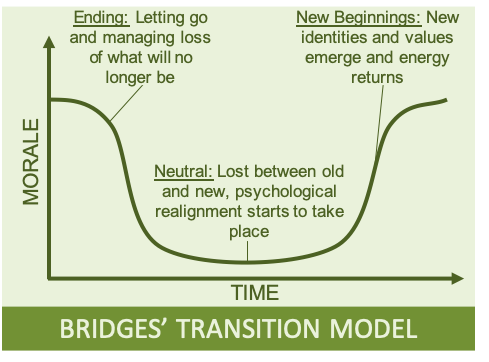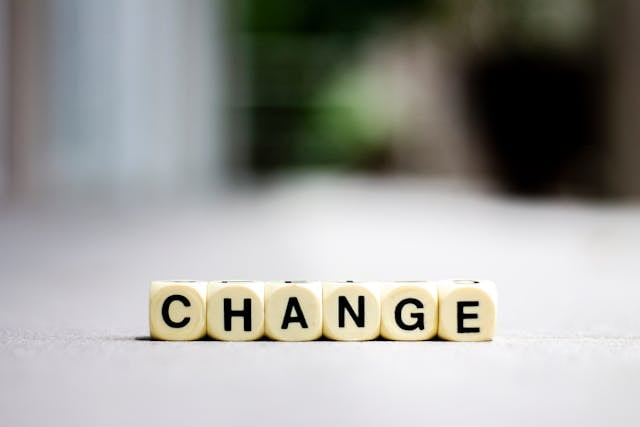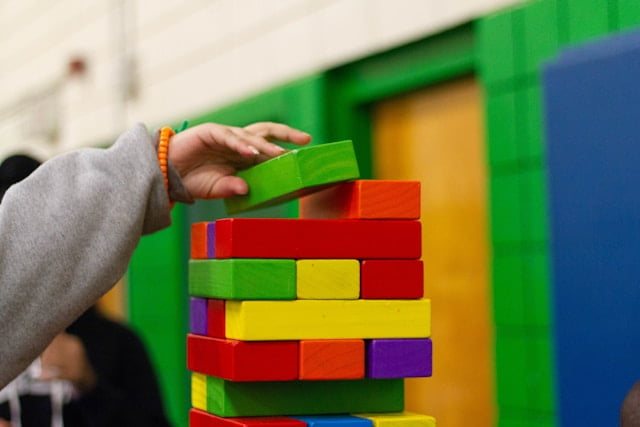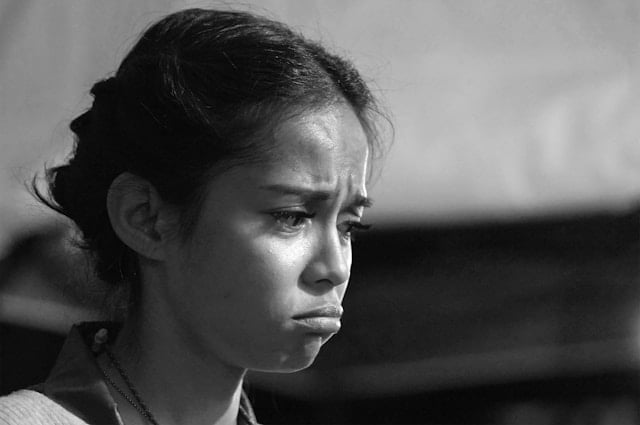Bridges’ transition model for change says that individuals transition through personal, psychological changes over three stages: ending, neutral zone and new beginnings. Individuals first grieve what they are letting go, before adopting new ways of being.
Summary by The World of Work Project
Bridges’ Transition Model for Change
Bridges’ transition model is a high level, three stage model of individual, psychological transition that has similarities to Elisabeth Kubler Ross’ change curve and to Otto Scharmer’s Theory U (which we’ve yet to write about). It also has similarities to organizational change models such as Lewin’s Change Model.

The first stage of Bridges’ model is “ending”, which relates to the loss of an old way of doing or being, and which corresponds to a downward trajectory in morale and engagement. The middle stage is the “neutral zone”, where moral remains low and the transition from old to new ways be doing or being starts. The final stage of this model is “new beginnings”, where individuals start to build new identities, values and ways of doing and being, morale and engagement pick up and individuals are reinvigorated.
Stage 1: Ending
Every movement in a new, personal, psychological direction starts with an assessment of a current way of doing or being, and letting that way go.
This process of an individual ending something about themselves often leads to a sense of loss. It can affect the emotional state of the individual experiencing change. Letting go of things that have served us is never easy.
Stage 2: Neutral zone
Once people have decided to let go of old beliefs, personal values, ways of working, relationships or other ways of being they often feel lost. They are preparing for something new, but don’t yet really know what it is.
In this stage people explore new ways of being. They learn new things, create new processes and start to head towards new beginnings.
Stage 3: New beginnings
As people explore their new ways of being they develop new understandings, personal values, relationships and beliefs. They also develop new ways of being and new ways of doing things.
As these new ways come into being individuals can see a different future for themselves. With this awareness comes a sense of excitement, energy, optimism and positivity about what’s to come.
Learning More
There are several different models that look at personal change. These include the Kubler-Ross change curve and the Transtheoretical Model.
Some aspects of personal change relate to understanding the power of habits. And once we understand them and how long it takes to form them, we can learn to replace our bad habits, so that we achieve better outcomes.
It’s also perhaps worth exploring the hero’s journey, which is the monomyth structure to many of the stories we all know. These stories are almost all stories of personal growth and change and so it is perhaps unsurprising that their main story arc aligns to several theories of personal change.
Habits are powerful things. We can reach the stage where we have Automaticity, the ability to do things without really thinking about them. You can learn more about habits in our podcast on them:
The World of Work Project View
Bridge’s transition model for change is a nice way to think about individual psychological change. It is similar to and links well with other, perhaps more well known, models.
Personal changes of this type, or transitions as Bridges refers to them, are not easy. They often lead to loss, frustration and confusion before new ways of doing or being start to crystallize.
This type of personal change model often appears in the world of coaching. A a high level awareness of this personal cycle is useful for both individuals looking to implement change. It’s also helpful for leaders or coaches looking to support others though change.
How We Help Organizations
We provide leadership development programmes and consulting services to clients around the world to help them become high performing organizations that are great places to work. We receive great feedback, build meaningful and lasting relationships and provide reduced cost services where price is a barrier.
Learning more about who we are and what we do it easy: To hear from us, please join our mailing list. To ask about how we can help you or your organization, please contact us. To explore topics we care about, listen to our podcast. To attend a free seminar, please check out our eventbrite page.
We’re also considering creating a community for people interested in improving the world of work. If you’d like to be part of it, please contact us.
Sources and Feedback
This post is based on original work by William Bridges and you can read more through the William Bridges Associated website.
We’re a small organization who know we make mistakes and want to improve them. Please contact us with any feedback you have on this post. We’ll usually reply within 72 hours.






